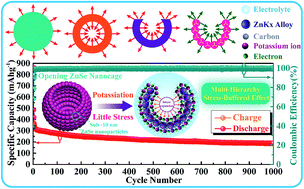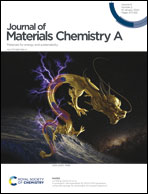Open ZnSe/C nanocages: multi-hierarchy stress-buffer for boosting cycling stability in potassium-ion batteries†
Abstract
Potassium ion batteries (KIBs) are considered to be emerging and promising grid-scale energy storage devices owing to earth-abundant potassium resources. A pivotal limitation of KIBs is the sluggish diffusion kinetics and structural degradation resulting from huge mechanical stress during the repeated intercalation/deintercalation of K+ ions. Herein, we design open ZnSe/C nanocages composed of sub-10 nm nanoparticles with a multi-hierarchy stress-buffering effect for KIBs. The primary ultrafine nanoparticles, the secondary open structure and the tertiary hollow structure as stepwise stress-release hierarchies can effectively reduce diffusion-induced stresses and greatly enhance the structural integrity, which is further validated by detailed finite element simulation analysis. Meanwhile, the carbon layer can enhance the electronic conductivity and suppress the agglomeration of ZnSe nanoparticles, achieving high-rate performance. Owing to these merits, the open ZnSe/C nanocages deliver a high reversible capacity of 318 mA h g−1 at 50 mA g−1 as well as excellent cyclability of 189 mA h g−1 up to 1000 cycles at 500 mA g−1. This work provides new insight into excellent structural design with a multi-hierarchy stress-buffering effect for advanced potassium storage.



 Please wait while we load your content...
Please wait while we load your content...